Massive primordial galaxies found nestling in vast halo of dark matter
6 December 2017
Two giant galaxies seen when the universe was only 780 million years old, or about 5% of its current age, have been identified by an international team involving UCL scientists using the Atacama Large Millimeter/submillimeter Array (ALMA).

The latest observations, published today in Nature, push back the epoch of massive-galaxy formation and reveal that these uncommonly large galaxies are nestled inside an even larger cosmic structure, a halo of dark matter several trillion times bigger than the sun.
The two galaxies are in such close proximity - less than the distance from the Earth to the center of our galaxy - that they will shortly merge to form the largest galaxy ever observed at that period in cosmic history. This discovery provides new details about the emergence of large galaxies and the role that dark matter plays in assembling the most massive structures in the universe.
"We expect the earliest galaxies that formed just a few hundred million years after the Big Bang to be 'nuggets' of stars and gas - perhaps with some similarities to dwarf galaxies we see in the nearby Universe. This system is anything but that, however. Our ALMA observations have revealed a massive system with extreme amounts of on-going star formation, gas, and dust at a time when the Universe was less than a billion years old, suggesting that these 'nuggets' of stars and gas were able to merge and form large galaxies very rapidly," explained co-author Dr Thomas Greve (UCL Physics & Astronomy)
"In fact, the presence of such an extremely massive galaxy - and the massive dark matter halo that is must reside in - this early on in the Universe's history is right at the limit of what is allowed by our best models of galaxy formation and evolution."
Professor Dan Marrone, University of Arizona in Tucson and lead author on the paper, said: "With these exquisite ALMA observations, astronomers are seeing the most massive galaxy known in the first billion years of the universe in the process of assembling itself."
Astronomers are seeing these galaxies during a period of cosmic history known as the Epoch of Reionization, when most of intergalactic space was suffused with an obscuring fog of cold hydrogen gas. As more stars and galaxies formed, their energy eventually ionized the hydrogen between the galaxies, revealing the universe as we see it today.
"We usually view that as the time of little galaxies working hard to chew away at the neutral intergalactic medium," said Professor Marrone. "Mounting observational evidence with ALMA, however, has helped to reshape that story and continues to push back the time at which truly massive galaxies first emerged in the universe."
The galaxies studied, collectively known as SPT0311-58, were originally identified as a single source by the South Pole Telescope. These first observations indicated that this object was very distant and glowing brightly in infrared light, meaning that it was extremely dusty and likely going through a burst of star formation. Subsequent observations with ALMA revealed the distance and dual nature of the object, clearly resolving the pair of interacting galaxies.
To make this observation, ALMA had some help from a gravitational lens, which provided an observing boost to the telescope. Gravitational lenses form when an intervening massive object, like a galaxy or galaxy cluster, bends the light from more distant galaxies. They do, however, distort the appearance of the object being studied, requiring sophisticated computer models to reconstruct the image as it would appear in its unaltered state.
This 'de-lensing' process provided intriguing details about the galaxies, showing that the larger of the two is forming stars at a rate of 2,900 solar masses per year. It also contains about 440 billion times the mass of our sun in gas and nearly 4 billion times the mass of our sun in dust.
The astronomers determined that this galaxy's rapid star formation was likely triggered by a close encounter with its slightly smaller companion, which already hosts about 35 billion solar masses of stars and is increasing its rate of starburst at the breakneck pace of 540 solar masses per year.
The researchers note that galaxies of this era are messier than the ones we see in the nearby universe. Their more jumbled shapes would be due to the vast stores of gas raining down on them and their ongoing interactions and mergers with their neighbours.
The new observations also allowed the researchers to infer the presence of a truly massive dark matter halo surrounding both galaxies. Dark matter provides the pull of gravity that causes the universe to collapse into structures (galaxies, groups and clusters of galaxies, etc.). By comparing their calculations with current cosmological predictions, the researchers found that this dark matter halo is one of the most massive that should exist at that time.
The team are now following up on more galaxies discovered with the South Pole Telescope with the aim of better understanding how quickly these galaxies came together and formed during reionization.
Links
- Research paper in Nature
- Dr Thomas Greve's academic profile
- UCL Physics & Astronomy
- UCL Mathematical & Physical Sciences
Image
- Artist impression of a pair of galaxies from the very early universe (credit: NRAO/AUI/NSF; D. Berry)
Source
Media contact
Bex Caygill
Tel: +44 (0)20 3108 3846
Email: r.caygill [at] ucl.ac.uk
 Close
Close

